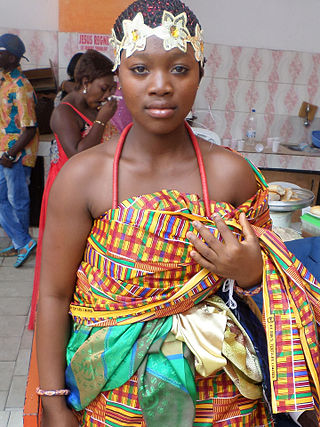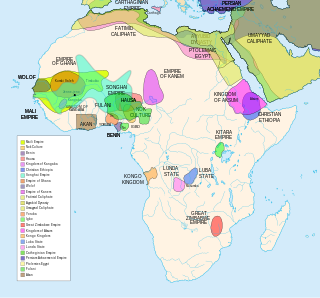Asante, also known as Ashanti, Ashante, or Asante Twi, is one of the principal members of the Akan dialect continuum. It is one of the three mutually intelligible dialects of Akan which are collectively known as Twi, the others being Bono and Akuapem. There are 3.8 million speakers of Asante, mainly concentrated in Ghana and southeastern Cote D'Ivoire, and especially in and around the Ashanti Region of Ghana.

Kente refers to a Ghanaian textile, made of handwoven cloth, strips of silk and cotton. Historically the fabric was worn in a toga-like fashion by royalty among the Akan. It originated from Bonwire in the Ashanti region of Ghana. In modern day Ghana, the wearing of kente cloth has become widespread to commemorate special occasions, with highly sought kente brands led by master weavers in demand. Kente is also worn in parts of Togo and Ivory Coast by the Akan people there.

The Mfantsefo or Fante are an Akan people. The Fante people are mainly located in the Central and Western regions of Ghana, occupying the forest and coastal areas. Their land stretches from the Pra estuary in the west to the Accra borders in the east. The Fante can be broadly categorized into two groups - the Borbor Fante and the non-Borbor Fante. Over the last half century, due to fishing expeditions, Fante communities have been established as far as Gambia, Liberia and even Angola. Major Fante cities in modern Ghana include Kasoa, Winneba, Agona Swedru, Tarkwa, Oguaa, Edina (Elmina), Mankessim, Sekondi, and Takoradi.
Osei Bonsu also known as Osei Tutu Kwame was the Asantehene. He reigned either from 1800 to 1824 or from 1804 to 1824. During his reign as the king, the Ashanti fought the Fante confederation and ended up dominating Gold Coast trade. In Akan, Bonsu means whale, and is symbolic of his achievement of extending the Ashanti Empire to the coast. He died in Kumasi, and was succeeded by Osei Yaw Akoto.
The Dyula are a Mande ethnic group inhabiting several West African countries, including Mali, Cote d'Ivoire, Ghana, and Burkina Faso.
The Akan people are a Kwa group living primarily in present-day Ghana and in parts of Ivory Coast and Togo in West Africa. The Akan speak dialects within the Central Tano branch of the Potou–Tano subfamily of the Niger–Congo family. Subgroups of the Akan people include: the Agona, Akuapem, Akwamu, Akyem, Anyi, Ashanti, Baoulé, Bono, Chakosi, Fante, Kwahu, Sefwi, Wassa, Ahanta, and Nzema, among others. The Akan subgroups all have cultural attributes in common; most notably the tracing of matrilineal descent in the inheritance of property, and for succession to high political office.
Bono State was a trading state created by the Bono people, located in what is now southern Ghana. Bonoman was a medieval Akan kingdom in what is now Bono, Bono East and Ahafo region respectively named after the and Eastern Ivory Coast. It is generally accepted as the origin of the subgroups of the Akan people who migrated out of the state at various times to create new Akan states in search of gold. The gold trade, which started to boom in Bonoman as early in the 12th century, was the genesis of Akan power and wealth in the region, beginning in the Middle Ages.
Opoku Ware I was the 2nd Asantehene of Oyoko heritage, who ruled the Ashanti Empire. Between 1718 and 1722, Opoku Ware became Asantehene during a period of civil disorder after the death of the 1st Asanthene. From 1720 to 1721, Opoku established his power.

The Bono, also called the Brong and the Abron, are an Akan people of West Africa. Bonos are normally tagged Akan piesie or Akandifo of which Akan is a derivative name. Bono is the genesis and cradle of Akans. Bono is one of the largest ethnic group of Akan and are matrilineal people. Bono people speak the Bono Twi of Akan language. Twi language, thus the dialect of Bono is a derivative of a Bono King Nana Twi. In the late fifteenth century, the Bono people founded the Gyaaman kingdom as extension of Bono state in what is now Ghana and Côte d'Ivoire.

Adinkra are symbols from Ghana that represent concepts or aphorisms. Adinkra are used extensively in fabrics, logos and pottery. They are incorporated into walls and other architectural features. Adinkra symbols appear on some traditional Akan goldweights. The symbols are also carved on stools for domestic and ritual use. Tourism has led to new departures in the use of the symbols in items such as T-shirts and jewellery.
The Mankessim Kingdom (1252–1844) was a pre-colonial African state in modern-day Ghana. It is regarded as the heartland of the Fante people, and operated as capital of the Fante Confederacy in the 19th century. The town of Mankessim still exists, and is located in the Central Region of Ghana, about an hour and a half drive west of Accra. The Mankessim Kingdom's influence was quite vast; it extended to the whole of the Fante people, and at times the entire coast of modern-day Ghana.
Articles related to Ghana include:

The Akyem are an Akan people. The term Akyem is used to describe a group of four states: Asante Akyem, Akyem Abuakwa, Akyem Kotoku and Akyem Bosome. These nations are located primarily in the eastern region in south Ghana. The term is also used to describe the general area where the Akyem ethnic group clusters. The Akyem ethnic group make up between 3-4 percent of Ghana's population depending on how one defines the group and are very prominent in all aspects of Ghanaian life. The Akyem are a matrilineal people. The history of this ethnic group is that of brave warriors who managed to create a thriving often influential and relatively independent state within modern-day Ghana. When one talks of Ghanaian history, there is often mention of The Big Six. These were six individuals who played a big role in the independence of Ghana. Of the big six, people of Akyem descent made up the majority.

The Asante Empire, today commonly called the Ashanti Empire, was an Akan state that lasted from 1701 to 1901, in what is now modern-day Ghana. It expanded from the Ashanti Region to include most of Ghana as well as parts of Ivory Coast and Togo. Due to the empire's military prowess, wealth, architecture, sophisticated hierarchy and culture, the Ashanti Empire has been extensively studied and has more historic records written by European, primarily British, authors than any other indigenous culture of sub-Saharan Africa.

African empires is an umbrella term used in African studies to refer to a number of pre-colonial African kingdoms in Africa with multinational structures incorporating various populations and polities into a single entity, usually through conquest.

Ghana–Ivory Coast relations refers to the diplomatic relations between Ghana and Ivory Coast. Both nations are members of the United Nations.

An akrafena is an Ashanti sword, originally meant for warfare but also forming part of Ashanti heraldry. The foremost example of an akrafena is the Mponponsuo, which belonged to Opoku Ware II. It has survived to the present day because it is still occasionally used in ceremonies, such as the Akwasidae Festival.
Osram ne nsoromma is one of the Bono Adinkra symbols, which is interpreted to mean "Osram" Moon "Ne" and "Nsoromma" Star. This symbol signifies love, bonding and faithfulness in marriage. The symbol is represented by a half moon with a star slightly hanging within the circumference of the moon. Adinkra are symbols that carry a message or a concept. They are very much used by the Bono people of the Bonoman and the Gyaman, an Akan people of Ghana and Côte d'Ivoire. Osram ne nsoromma symbols are incorporated into walls and other architectural features and quite recently has become common with tattoo designers. The most common ways through which the Adinkra messages are carried out or conveyed is having them printed extensively in fabrics and used in pottery.
Tano (Tanoɛ), whose true name is Ta Kora, but is often confused with Tano Akora, and is known as Tando to the Fante is the Abosom of war and strife in Akan mythology and Abosom of Thunder and Lightning in the Asante mythology of Ghana as well as the Agni mythology of the Ivory Coast. He represents the Tano River, which is located in Ghana. He is regarded as the highest atano, or Tano abosom in Akan mythology.











